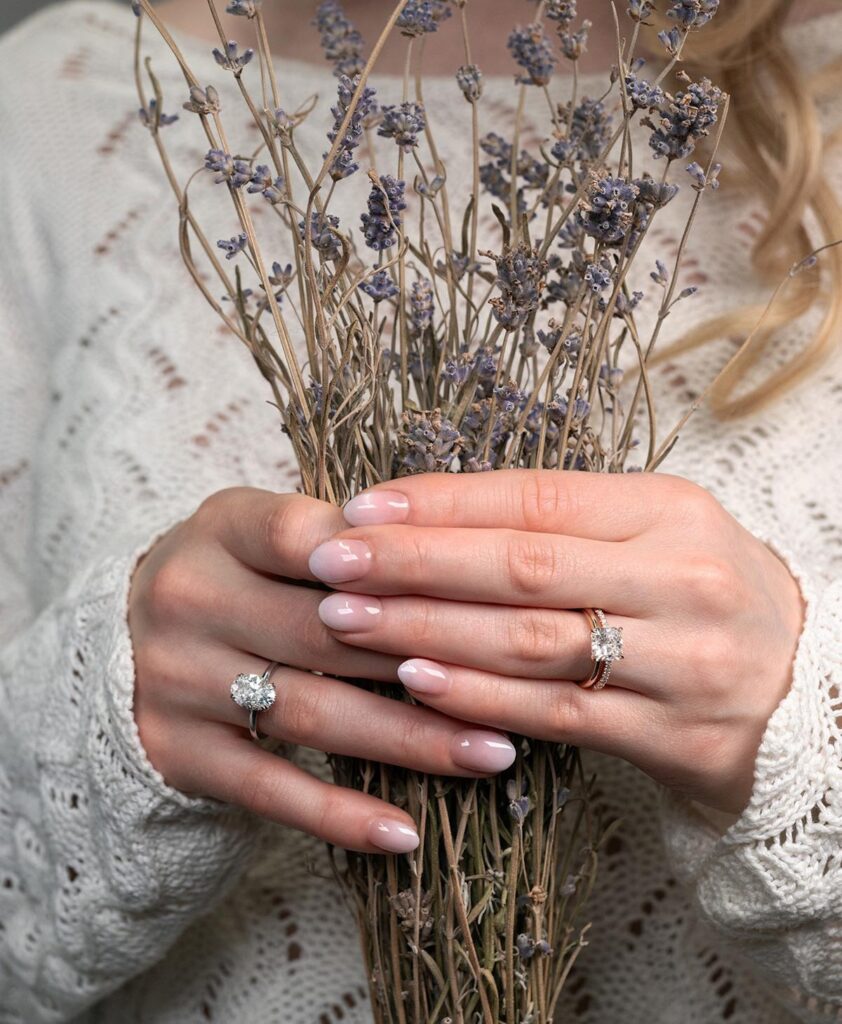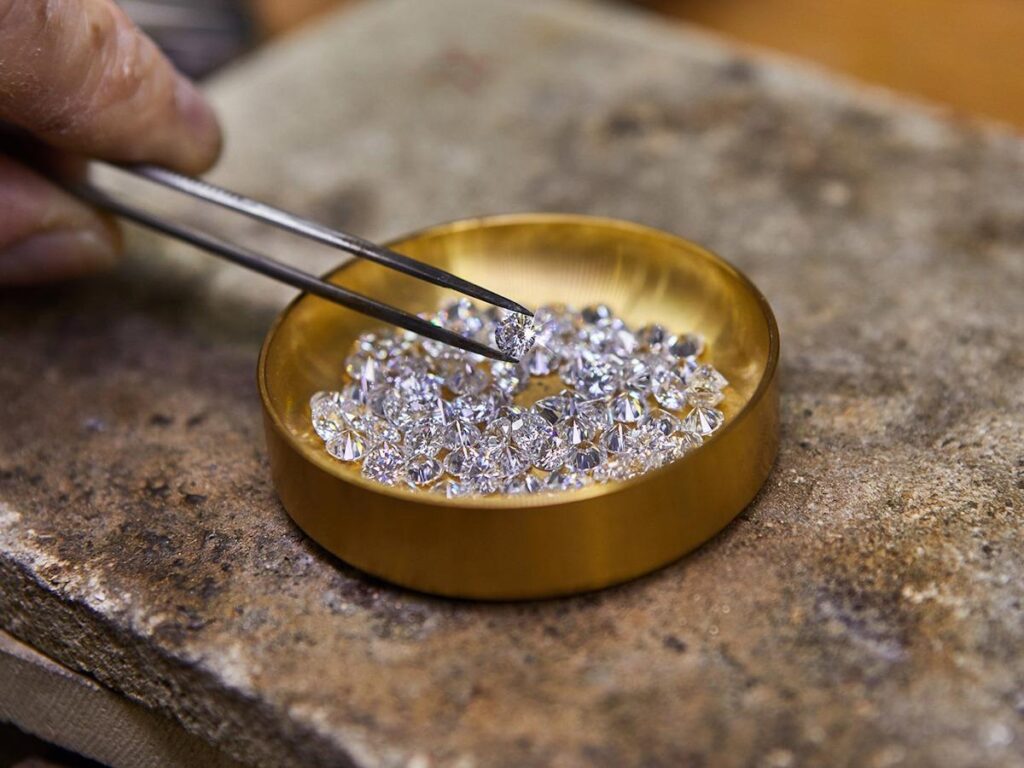When you’re looking for a ring that sparkles brilliantly and stands the test of time, laboratory-grown diamonds offer an excellent alternative to traditional natural diamonds. Lab-grown diamonds are real diamonds with the same properties as mined ones. The only difference lies in their origin: synthetic diamonds are cultivated in a laboratory using advanced technology.
The price of a laboratory-grown diamond is often significantly lower compared to a natural diamond. This makes it especially appealing when you’re looking for a show-stopping ring with a stone that’s sure to catch the eye. With the same budget, you can choose a larger diamond or several smaller ones. However, affordability doesn’t mean compromising on quality. Lab-grown diamonds are graded using the same criteria as natural diamonds, and their brilliance and durability are identical.
Every ring in the Goldsmiths Andreasen wedding ring collection can be crafted according to the customer’s wishes, either with a natural or a laboratory-grown diamond. The wedding ring collection offers a wide range of designs — from classic solitaire rings and elegant diamond bands to bolder models featuring striking details. Each ring is custom-made in Tampere, Finland, allowing the customer to select the size, shape, and number of diamonds to create a piece that is truly unique and personal.
For lovers of timeless elegance, the Classic ring is an excellent choice. Its clean, minimalist design highlights the beauty of the diamond, making it the focal point. For those seeking a more eye-catching look, the Tulppaani (Tulip) ring features a decorative setting that beautifully showcases the diamond row’s brilliance — a true showpiece.

What Are Laboratory-Grown Diamonds?
A laboratory-grown diamond is a real diamond produced synthetically using modern technology, while a natural diamond forms deep within the Earth over millions of years. In a lab, diamonds are grown under controlled conditions that replicate the extreme pressure and heat found in nature. This allows crystallization to occur much faster — within weeks or months — but the end result is the same: a bright and durable gemstone.
Chemically, physically, and optically, a laboratory-grown diamond is identical to a natural diamond. Its structure, hardness, and brilliance are the same. The only distinction is its origin — a lab-grown diamond is created in human-made conditions — but its beauty and value are every bit as genuine.
Producing synthetic diamonds does not require mining, making it a more environmentally friendly and ethically responsible choice. A laboratory-grown diamond ring combines timeless symbolism, modern technology, and the opportunity to own a stunning piece without exceeding your budget.
How a Diamond Is Made in the Laboratory
The creation of diamonds has been possible since the 1950s, though early methods produced stones of lower quality. The original process, which simulated the heat and pressure under which natural diamonds form, was slow. Another technique involved growing a diamond by introducing carbon gas in a vacuum over a microscopic diamond seed, allowing the gas to crystallize. This produced purer diamonds, though the process was still inefficient.
Today, manufacturers combine the best aspects of both methods. While the process remains time-consuming and energy-intensive, it now produces pure, large diamonds that goldsmiths can use in their creations.

Custom-Made Wedding Rings
A laboratory-grown diamond offers an excellent opportunity to create the ring you’ve always dreamed of. Since the diamond has the same properties as a natural one, it can be set into any ring design and paired seamlessly with various precious metals. The result is a unique piece that tells the wearer’s story — just as an engagement or wedding ring should.
At Goldsmiths Andreasen, every laboratory-grown diamond ring is made to order, crafted precisely to the customer’s size and preferences. The details can be designed together with the goldsmith, allowing choices in diamond size, shape, quantity, and band material. The result is a ring that fits perfectly and complements the wearer’s personal style.
A key advantage of laboratory-grown diamonds is their affordability, which offers more freedom in design. With the same budget, you can select a larger center stone or a diamond band for a more striking look. The collection includes a wide variety of styles — from classic solitaires to stunning halo designs and modern diamond bands.
For example, the Lumivuokko halo ring offers romantic brilliance. A halo of small diamonds encircles the center stone, creating an exceptionally radiant look. The Lumivuokko is available in several shapes and is perfect for those who desire a touch of luxury and sparkle.
For a more minimalist aesthetic, the Vendela ring is a streamlined and practical design with a diamond set low in the band. Its modern and understated style makes it ideal for everyday wear — comfortable on the finger and unlikely to snag. Vendela is elegant, timeless, and suited for daily use.
If desired, customers can also commission a completely unique custom-made piece, designed in collaboration with the goldsmith down to every detail — from the choice of materials to the diamond’s shape.
Why Choose a Laboratory-Grown Diamond for Your Ring?
A laboratory-grown diamond offers many advantages. First, it’s significantly more affordable than a natural diamond, allowing you to choose a larger or more elaborate stone within the same budget. Second, it’s a responsible choice, as its production doesn’t involve mining, reducing environmental impact. Third, it provides creative freedom — enabling you to select even rare color variations that are seldom found in nature.
Appearance and Quality Equal to Natural Diamonds
A laboratory-grown diamond looks identical to a mined diamond. To the naked eye, there is no visible difference, and even professionals need specialized instruments to determine a diamond’s origin.
The quality of a synthetic diamond is assessed by the same criteria as a natural diamond — carat, color, clarity, and cut. A lab-grown diamond does not fall short in any respect. It shines brightly, withstands everyday wear, and retains its value. In terms of beauty or durability, there is no need for compromise.
